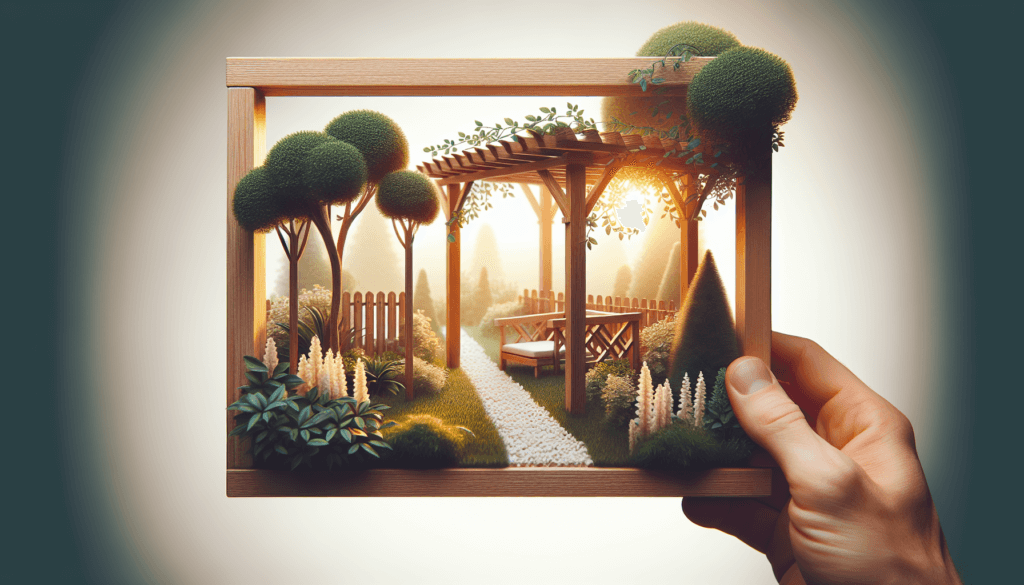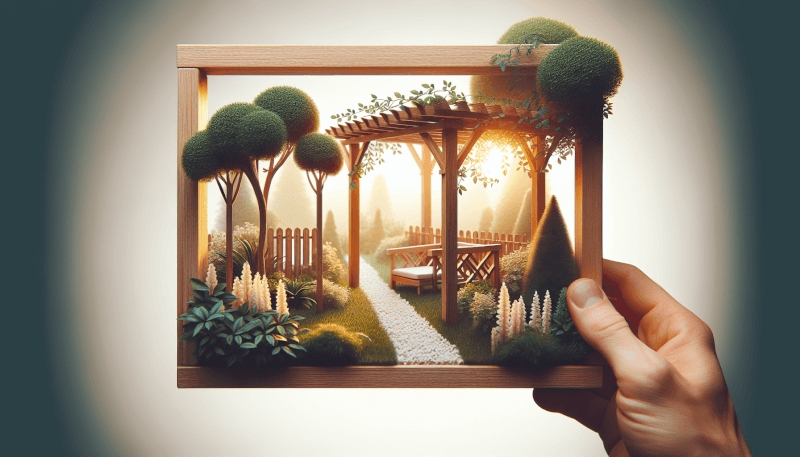So, you’ve been dreaming of creating a cozy oasis right in your backyard, a place where you can unwind and enjoy the beauty of nature? Look no further! In this article, we will guide you on how to build your very own DIY garden pergola. Whether you’re an experienced DIY enthusiast or a complete novice, we’ve got you covered with easy-to-follow steps and expert tips. Get ready to transform your outdoor space into a picturesque haven with a touch of your personal flair.

Choosing the Right Location
When it comes to building a DIY garden pergola, choosing the right location is crucial. You’ll want to assess your garden space to determine the ideal spot for your pergola. Consider the size and shape of your garden, as well as any existing structures or landscaping features that may affect the placement of your pergola.
Next, think about sun exposure. Pergolas are often built to provide shade, so it’s important to select a location that receives the right amount of sunlight throughout the day. Take note of which areas of your garden get the most sun and find a spot that strikes the perfect balance between sun and shade.
In addition to sun exposure, you’ll also need to account for other elements such as wind and rain. Pergolas can offer protection from the elements, but it’s important to choose a location that is not too exposed to strong winds or heavy rain.
Lastly, before you start building, check your local building regulations. Different areas may have specific rules and regulations regarding the construction of outdoor structures like pergolas. Make sure to obtain any necessary permits and adhere to any guidelines to ensure that your DIY project is in compliance with local regulations.
Preparing the Ground
Once you’ve chosen the perfect location for your garden pergola, it’s time to prepare the ground. First, clear the area of any vegetation, rocks, or debris. You’ll want a clean and level surface to work with.
Next, ensure that the ground is level. Use a level to check for any unevenness and make adjustments as needed. A level surface is crucial for the stability and longevity of your pergola.
Take the time to remove any obstacles that may hinder the construction of your pergola. This includes things like tree stumps, large rocks, or old fence posts. Clearing the area will ensure a smooth and seamless construction process.
After clearing the area and leveling the ground, it’s time to mark the boundaries of your pergola. Use stakes and string to outline the area where your pergola will be located. This will serve as a visual guide as you begin the construction process.
You’ll also want to measure and mark the postholes. The location and depth of the postholes will depend on the size and design of your pergola. Measure carefully and mark the spots where the posts will be inserted into the ground.
Gathering Materials and Tools
Before you start building your DIY garden pergola, gather all the necessary materials and tools. Start by choosing the right wood for your pergola. Cedar is a popular choice due to its durability and resistance to decay, but other woods like redwood or pressure-treated lumber can also work well.
Once you’ve selected the wood, consider the appropriate fasteners. Stainless steel screws or galvanized nails are recommended for outdoor structures, as they provide strength and resistance to rust. Choose the right size fasteners for the thickness of the wood you’re using.
As you plan your pergola, think about any additional features you may want to include, such as benches or planter boxes. These can add functionality and aesthetics to your pergola. Consider the materials needed for these features and incorporate them into your shopping list.
Lastly, make sure you have all the necessary tools to complete the project. A saw, drill, level, tape measure, and a posthole digger or auger are essential tools for building a pergola. Gather these tools before you start construction to ensure a smooth and efficient building process.
Building the Foundation
The foundation of your DIY garden pergola is where it all begins. Start by digging the postholes according to the measurements and markings you made earlier. The depth of the postholes will depend on the height and design of your pergola, but typically they should be dug to a depth of around 2 feet.
Once the postholes are dug, it’s time to pour concrete footings. This will provide a solid and stable base for your pergola. Follow the instructions on the concrete mix and use a level to ensure that the footings are level and aligned correctly.
Next, insert the posts into the ground. Make sure they are positioned securely in the concrete footings. Use a level to ensure that the posts are straight and plumb. Take your time with this step, as it is essential for the stability and structural integrity of your pergola.
After inserting the posts, it’s important to allow sufficient time for the concrete to cure. This typically takes 24 to 48 hours, but follow the instructions on the concrete mix for specific curing times. Avoid putting any weight or stress on the posts during this curing period.

Constructing the Pergola Frame
Once the foundation is in place, it’s time to start constructing the pergola frame. Start by cutting the beams and crossbeams according to the dimensions of your pergola design. Take accurate measurements and use a saw to make clean cuts.
Next, attach the beams to the posts. This can be done using metal brackets or by notching the end of the beams and fitting them securely onto the posts. Make sure the beams are level and aligned correctly before securing them in place.
After attaching the beams, it’s time to install the crossbeams. These will create the lattice effect on the top of your pergola. Measure and cut the crossbeams to the desired length, ensuring proper spacing and alignment. Attach them securely to the beams using screws or nails.
As you construct the pergola frame, it’s important to use braces for stability. Braces can be attached diagonally between the posts and beams for added support. Measure and cut the braces to the appropriate length, ensuring they are securely fastened to the posts and beams.
Adding Support and Bracing
To further enhance the stability of your DIY garden pergola, it’s important to add additional support beams. These beams can be installed parallel to the existing beams, providing extra strength and rigidity to the structure. Attach them securely to the posts and crossbeams using screws or nails.
In addition to the support beams, installing braces can provide extra stability. Braces can be attached diagonally between the posts and beams for added strength. Measure and cut the braces to the appropriate length, ensuring they are securely fastened.
After adding the support beams and braces, it’s important to check for strength and rigidity. Apply pressure to different parts of the pergola to ensure it is stable and secure. Make any necessary adjustments or reinforcements to ensure the structural integrity of your pergola.

Installing the Roof
The roof of your DIY garden pergola is an important component, as it provides shade and protection from the elements. Choose the right roofing material for your pergola, taking into consideration factors such as durability and aesthetics. Options include fabric, polycarbonate panels, or even shade cloth.
Once you’ve chosen the roofing material, it’s time to cut and prepare the roof panels. Measure the dimensions of your pergola and cut the panels accordingly. Ensure that the panels fit securely and snugly onto the pergola frame.
Attaching the roof panels securely is vital for the longevity of your pergola. Use appropriate fasteners such as screws or nails to secure the panels to the beams and crossbeams of the pergola frame. Make sure the panels are evenly spaced and aligned for a polished and professional look.
Proper water drainage is essential for the durability of your pergola. Ensure that the roof panels are angled correctly to allow rainwater to flow off the roof and prevent pooling. If necessary, use additional materials such as gutters or downspouts to guide the water away from the pergola.
Finally, seal any gaps or seams between the roof panels to prevent water leakage. This can be done using caulk or weatherproof sealant. Pay attention to any areas where the roof panels meet the beams or crossbeams, as these are common areas for water to seep through.
Adding Finishing Touches
Once the main structure of your DIY garden pergola is complete, it’s time to add the finishing touches. This includes staining or painting the pergola to enhance its appearance and protect the wood from weathering.
Choose a stain or paint color that complements your garden aesthetic. Apply the stain or paint evenly to all surfaces of the pergola, following the manufacturer’s instructions for application and drying times. This step will not only add beauty but also increase the longevity of your pergola.
Applying a weatherproof finish is another important step in maintaining the durability of your pergola. Use a weatherproof sealant or varnish to protect the wood from moisture, UV rays, and other outdoor elements. Apply the finish according to the manufacturer’s instructions for the best results.
To further enhance the beauty and functionality of your garden pergola, consider adding decorative elements. Vines or climbing plants can be trained to grow up and around the pergola, providing natural shade and a lush green backdrop. You can also incorporate outdoor lights or fairy lights to create a cozy ambiance in the evenings.
In addition, consider building optional features such as benches or planter boxes. These can be constructed using the same wood and tools you used for the pergola, creating a cohesive and integrated look. These features will not only add functionality but also make your pergola a truly customized space.

Maintaining the Pergola
To ensure the longevity and enjoyment of your DIY garden pergola, regular maintenance is key. Start by regularly cleaning the pergola to remove dirt, debris, and any build-up of leaves or moss. This can be done using a brush, mild soap, and water. Regular cleaning will help prevent staining and deterioration of the wood.
Inspect your pergola periodically for any signs of damage or wear. Check for loose or damaged fasteners, cracks in the wood, or any other issues that may compromise the integrity of the structure. Address any repairs promptly to prevent further damage and ensure the safety of your pergola.
As part of regular maintenance, consider resealing or repainting your pergola on an annual basis. This will help protect the wood from weathering and keep it looking fresh and vibrant. Follow the manufacturer’s instructions for the specific product you are using, and make sure to apply the sealant or paint evenly and thoroughly.
Over time, you may need to replace or update certain parts of your pergola. This could include replacing worn-out wood, updating fasteners, or refreshing the roofing material. Stay vigilant and address any necessary repairs or updates promptly to maintain the functionality and beauty of your garden pergola.
Conclusion
Building a DIY garden pergola is a rewarding project that can enhance your outdoor living space. By carefully choosing the right location, preparing the ground, gathering the necessary materials and tools, and following a step-by-step construction process, you can create a beautiful and functional pergola.
Enjoy the benefits of your DIY garden pergola by customizing and personalizing the space to suit your needs and tastes. Admire the beauty and functionality of your creation as you relax in the shade, entertain friends and family, and create lasting memories in your own outdoor oasis. With regular maintenance and care, your pergola will continue to provide enjoyment for years to come. So, roll up your sleeves, gather your tools, and get ready to embark on your DIY garden pergola journey!



